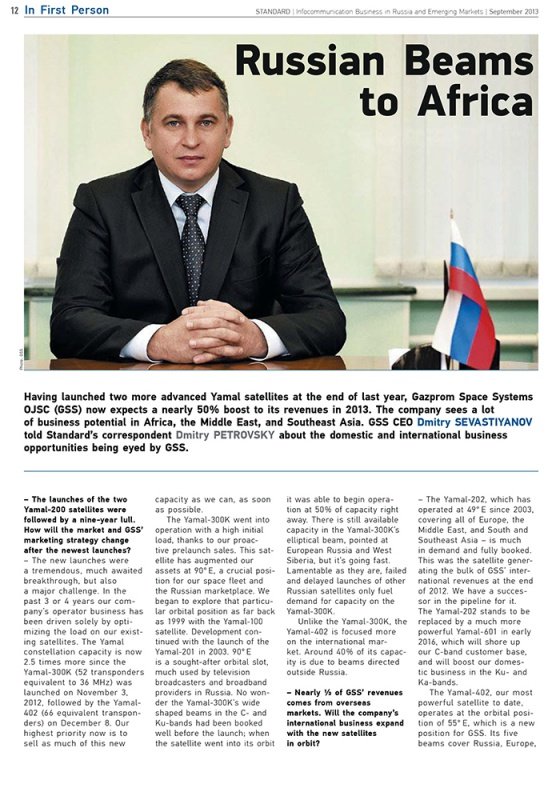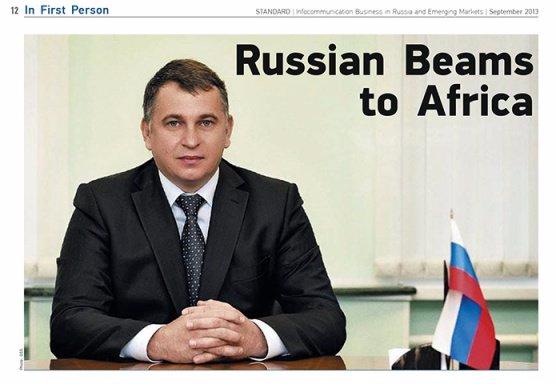News
 16 September 2013
16 September 2013
Russian Beams to Africa
Having launched two more advanced Yamal satellites at the end of last year, Gazprom Space Systems OJSC (GSS) now expects a nearly 50 % boost to its revenues in 2013. The company sees a lot of business potential in Africa, the Middle East, and Southeast Asia. GSS CEO Dmitry SEVASTIYANOV told Standardâs correspondent Dmitry PETROVSKY about the domestic and international business opportunities being eyed by GSS.
Having launched two more advanced Yamal satellites at the end of last year, Gazprom Space Systems OJSC (GSS) now expects a nearly 50% boost to its revenues in 2013. The company sees a lot of business potential in Africa, the Middle East, and Southeast Asia. GSS CEO Dmitry SEVASTIYANOV told Standard's correspondent Dmitry PETROVSKY about the domestic and international business opportunities being eyed by GSS.
- The launches of the two Yamal-200 satellites were followed by a nine-year lull. How will the market and GSS’ marketing strategy change after the newest launches?
The new launches were a tremendous, much awaited breakthrough, but also a major challenge. In the past 3 or 4 years our comÂpany's operator business has been driven solely by optimizing the load on our existÂing satellites. The Yamal constellation capacity is now 2.5 times more since the Yamal-300K (52 transponders equivalent to 36 MHz) was launched on November 3, 2012, followed by the Yamal-402 (66 equivalent transponders) on December 8. Our highest priority now is to sell as much of this new capacity as we can, as soon as possible.
The Yamal-300K went into operation with a high initial load, thanks to our proactive prelaunch sales. This satellite has augmented our assets at 90° E, a crucial position for our space fleet and the Russian marketplace. We began to explore that particular orbital position as far back as 1999 with the Yamal-100 satellite. Development continued with the launch of the Yamal-201 in 2003. 90° E is a sought-after orbital slot, much used by television broadcasters and broadband providers in Russia. No wonder the Yamal-300K's wide shaped beams in the C- and Ku-bands had been booked well before the launch; when the satellite went into its orbit it was able to begin operation at 50% of capacity right away. There is still available capacity in the Yamal-300K's elliptical beam, pointed at European Russia and West Siberia, but it's going fast. Lamentable as they are, failed and delayed launches of other Russian satellites only fuel demand for capacity on the Yamal-300K.
Unlike the Yamal-300K, the Yamal-402 is focused more on the international market. Around 40% of its capacity is due to beams directed outside Russia.
- Nearly 1/3 of GSS' revenues comes fr om overseas markets. Will the company's international business expand with the new satellites in orbit?
- The Yamal-202, which has operated at 49° E since 2003, covering all of Europe, the Middle East, and South and Southeast Asia - is much in demand and fully booked. This was the satellite generating the bulk of GSS' international revenues at the end of 2012. We have a successor in the pipeline for it. The Yamal-202 stands to be replaced by a much more powerful Yamal-601 in early 2016, which will shore up our C-band customer base, and will boost our domestic business in the Ku- and Ka-bands.
The Yamal-402, our most powerful satellite to date, operates at the orbital position of 55° E, which is a new position for GSS. Its five beams cover Russia, Europe, the Middle East, and Sub- Saharan Africa. Customers will need some time to get accustomed to the new spot and new satellite. In Russia, wh ere we also wanted to get our customers to feel comfortable with a satellite asset at 55° E, GSS rented the Astra 1F satellite from global operator SES and set it to work at that same position for 18 months. Covering the European part of Russia, the Astra 1F brought us new customers and thus secured enough business for the Yamal-402 to start with in Russia. All Astra IF clients switched to the Yamal-402, loading nearly a quarter of the new satellite's capacity, dedicated to Russia, right away. The new challenge for us is to sell the Yamal-402's "international" beams. However, the satellite's competitive parameters and its high quality capacity make us feel confident about international sales.
- Does the Yamal-402 cover Africa? What are some of the challenges and nuances of doing business in Africa?
- Competition is pretty tough between satellite operators in Africa. All the major global satellite operators a have solid presence in Africa - Intelsat, SES, Eutelsat, and Telesat, as well as some strong regional operators. Demand for satellite communications and broadcasting far exceeded supply in the mid-2000s.
In just two years, starting in 2009, 13 satellite operators launched or transferred from other positions about 20 satellites with beams covering Sub-Saharan Africa. More than 200 transponders were added to enhance capacity during that time, while coastal Africa became entangled in a maze of powerful submerged fiber optic cables. However, inner Africa, which does not have so many access networks, still needs satellite services very much. Numerous large NGOs operate in Africa, as do mining, oil, gas, shipping, and logistics companies. The majority of European teleports are focused to operate in Africa.
There are plenty of customers for the Yamal-402's southern beam, which has good coverage of all Central, East, and South Africa and has connection with Europe.
- What does GSS do to get a foothold in new markets?
We make an effort in our new markets to raise awareness of our company and what we have to offer. GSS has recently set up a new sales department, which will focus exclusively on the emerging economies. We try to never miss a chance to meet our potential customers face to face. This helps to build trust and eliminate bias. Last May, GSS visited the Satcom Africa expo in Johannesburg, South Africa. Coming up next is AfricaCom in Cape Town in November. We urge our customers to give our satellite asset a try so they can fully appreciate it. We are probing the markets in South and Southeast Asia with the Yamal-402's steerable beam.
So far, the Yamal-402 has been positioned on the international market mostly as a satellite for telecom providers (point-to-point channels, VSAT services, Internet access, content transfer, etc.). But there is no reason for this satellite not to accommodate TV packages at some point, including DTH platforms. The Yamal-402 is powerful enough for this.
- How soon are you planning to fully load both new satellites?
- We expect the loading process to accelerate in late 2013 or early 2014, and we plan to reach full load by the beginning of 2015.
- What is the estimated payback period for the Yamal-402, and what is its lifetime?
- A modern telecom satellite typically takes about five years to pay for itself. The Yamal-402 has been in commercial use since last February. An abnormal launch has lost us 3.5 years, but the satellite still has 11.5 years of active life ahead. This is quite enough time for long-term projects of any nature.
- How will GSS use the insurance money it received for the Yamal-402's irregular launch?
The insurance indemnification of ⎠73 million will be used, first of all, to service the investment loans we took out to pay for the satellite. We also want to invest some of the money in replacement and development of our satellite fleet.
The Yamal-601 satellite is a large part of our orbital infrastructure development plans. The satellite will be built by Thales Alenia Space, which won Gazprom's tender, and launched by Proton.
- When is the next GSS satellite due for launch?
- The Yamal-401 with the Russian C- and Ku-band beams and 88 equivalent transponders, which is currently being built by ISS Reshetnev, is tentatively scheduled for launch in the first half of next year.
- Will the launch of the Yamal-401 have any impact on GSS' international business?
- Yes, and a very strong impact indeed. Once the Yamal-401 is in place at 90° E, it will take over the entire load of the
Yamal-300K, which will then be moved much farther east, to 183°E. From this point, the Yamal-300K will cover the Far East, Northern China, the Korean Peninsula, Japan, and Northern Pacific (busy maritime shipÂping routes), extending as far as the US West Coast. The steerable beam will be pointed to Australia or some other part of the Pacific.
We will not see this satellite from our teleport at Shchelkovo near Moscow, so we'll have to build new TT&C facilities and teleport near Khabarovsk, which will be a desirable addition to our ground infrastructure.
- Did the recent failure of the Russian Express-MD1 satellite affect GSS in any way?
- The Russian Television and Radio Broadcasting Network used C-band capacity on GSS satellites (mostly Yamal-202) already in 2012, because the Russian Satellite Communications Company (RSCC) was experiencing a capacity shortage.
When the Express-MDI crashed at the beginning of July 2013, we were able to offer extra capacity on the Yamal-202, as well as capacity on our new satellites Yamal-300K and Yamal-402. This was not easy: the C-band beams on our satellites were almost fully booked at the time. It was hard work to rearrange our capacity. The result is that GSS satellites now accommodate some additional digital TV packages of the first multiplex (we have 11 of them now), and some regional TV channels. This has added somewhat to our revenues, but earnings were not our primary concern in this case. It was a task of national importance, and that means a lot to us. Television companies and the government once again realized how fortunate it is that we don't have just one satellite operator for the whole country.
Fair competition is one thing, but it's also great to have a backup for important national projects.
ID : 7913
Mnemonic code:
Name: Russian Beams to Africa
Tags: publications, Yamal-402, Yamal-601
Preview image:

Information Block ID: 66
Information Block mnemonic code: news
Information Block name: News
ÐÐĩŅŅÐļКаÐŧŅÐ―Ð°Ņ КаŅŅÐļÐ―ÐšÐ° ÐīÐŧŅ Ð°Ð―ÐūÐ―Ņа: N
ÐзÐīаŅÐĩÐŧŅŅŅÐēÐū: STANDARD
Infocommunication Business in Russia and Emerging Markets
September 2013
ÐĪаÐđÐŧ Ņ ÐŋŅÐąÐŧÐļКаŅÐļÐĩÐđ: Download
